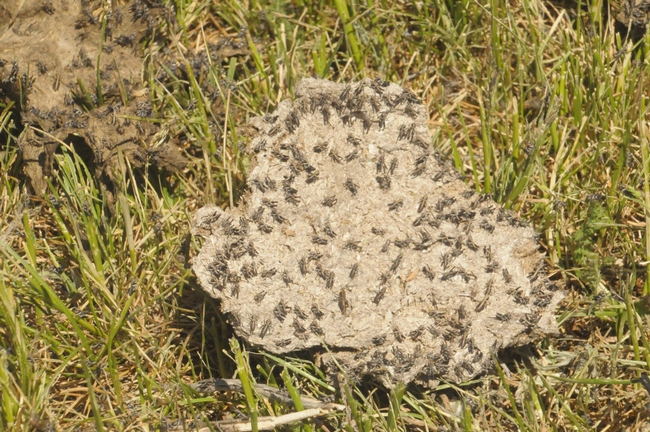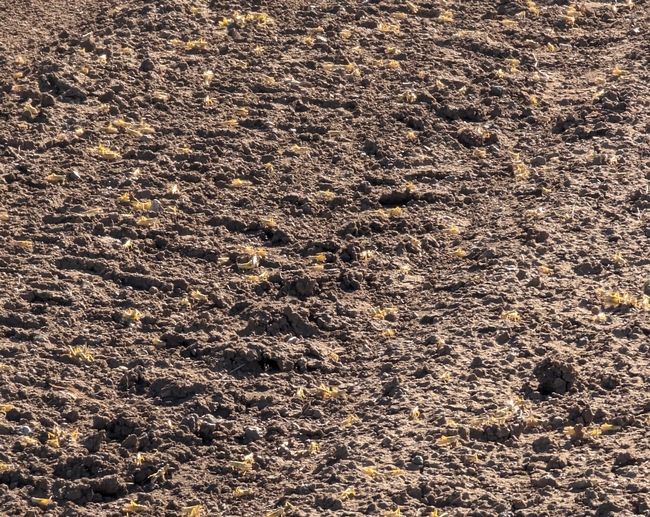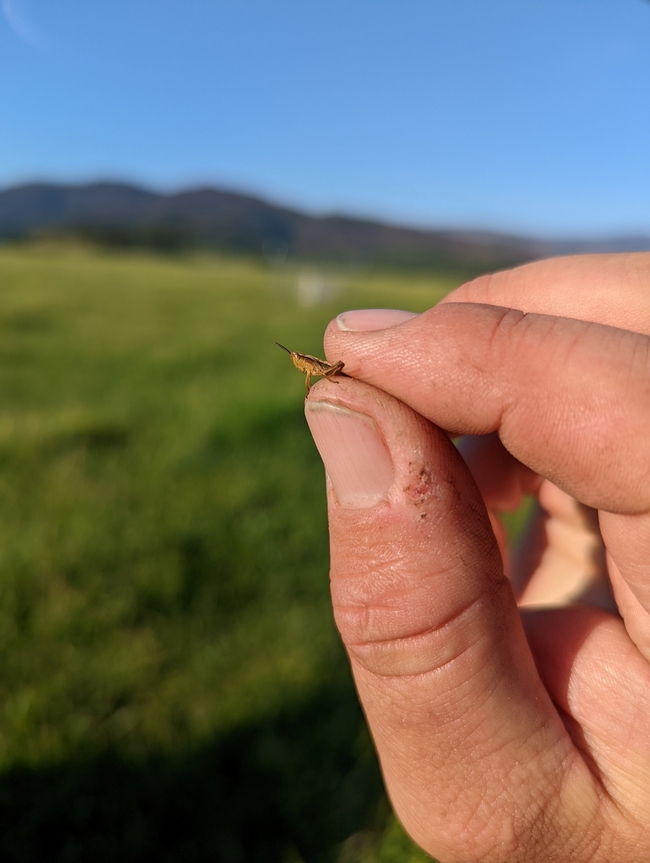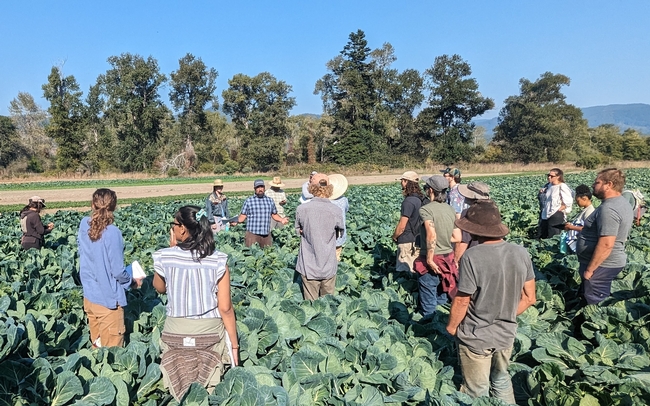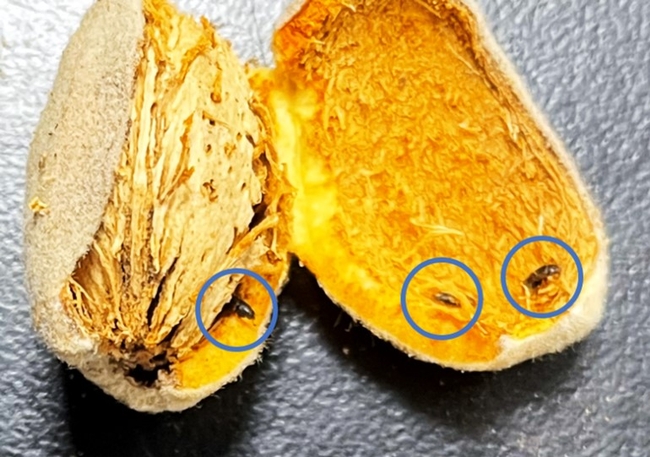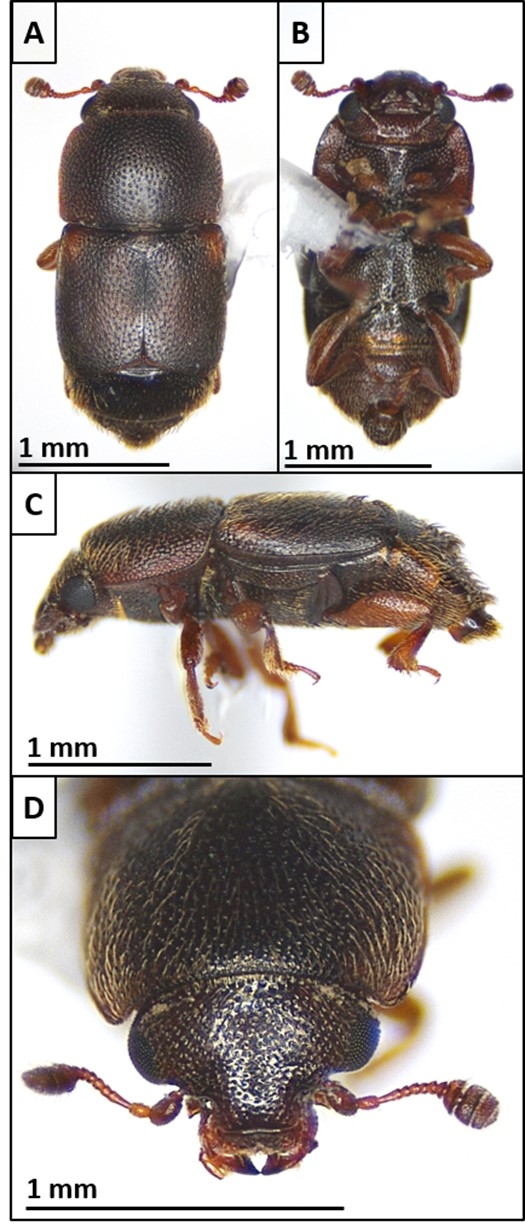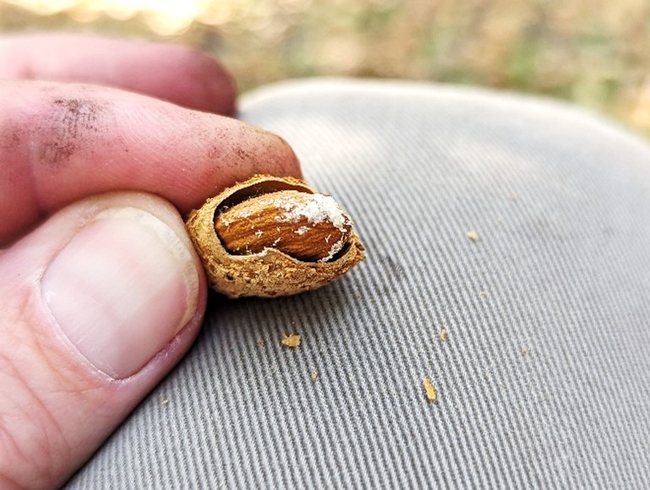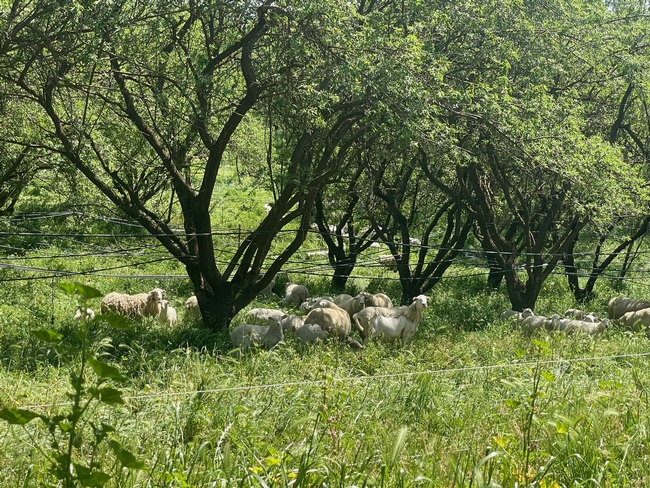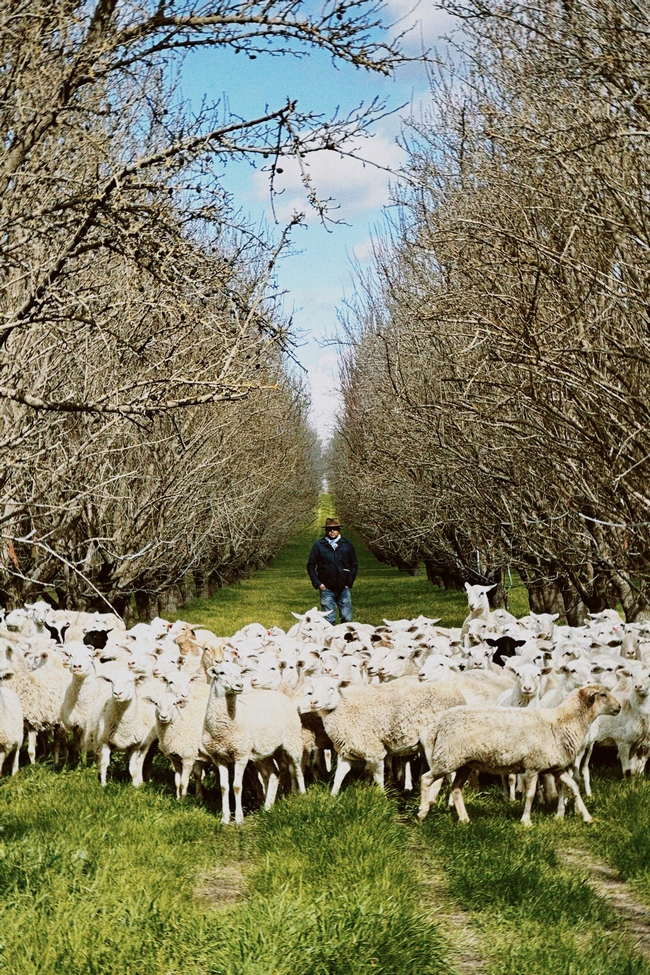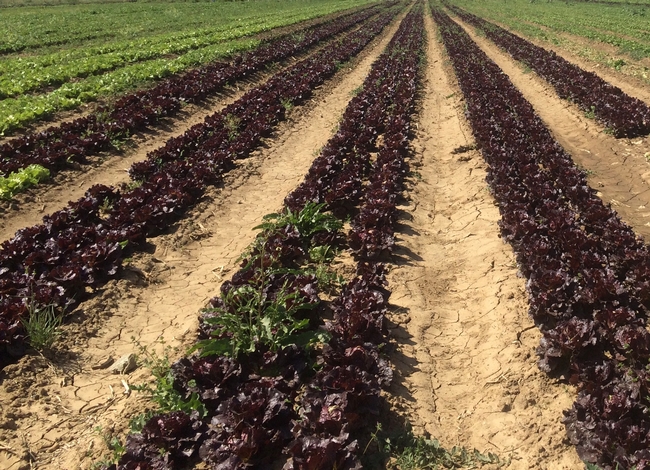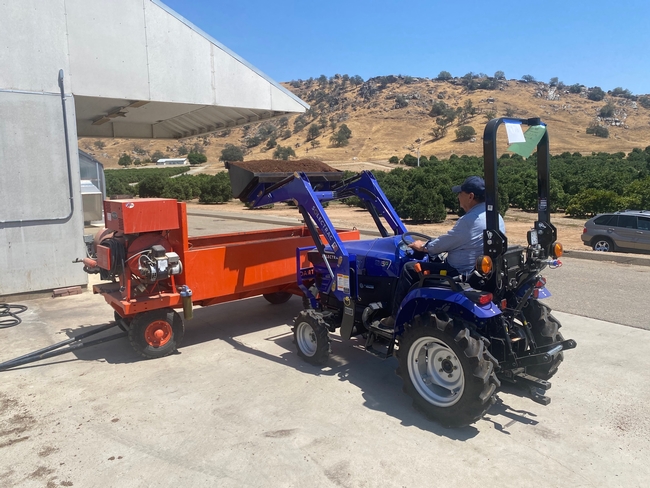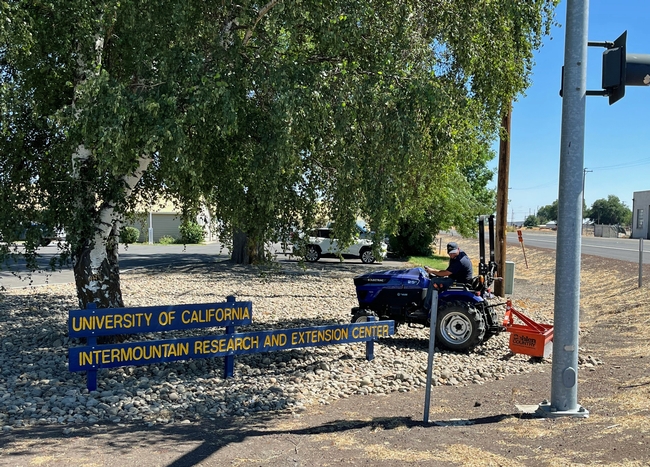
Posts Tagged: E. O. Wilson
Grasshoppers gobble crops, farm profits
UCCE advisors share control, abatement strategies across Northern California
That buzzing noise in Northern California is the sound of grasshoppers chewing a path of destruction through crops and pollinator-friendly plants as they hop across an expanding area.
This is the fifth year in a row that massive numbers of grasshoppers have overrun Modoc County and “probably the worst I've seen yet,” said Laura Snell, a University of California Cooperative Extension livestock and natural resource advisor in Modoc County, located in the northeastern corner of the state.
In past years, Snell has heard from farmers who have lost up to 70% of their hay crop. This year, she is hearing of grasshopper damage from farmers who grow a wider array of crops, including onions and garlic – crops that the pests eschewed in past years.
“I've had an even broader group of producers contact me about damage,” Snell said. “Our local vegetable producers are being affected, decreasing farmers market and food hub products. Bee producers are not seeing good honey yields due to grasshoppers eating huge amounts of pollinator plants.”
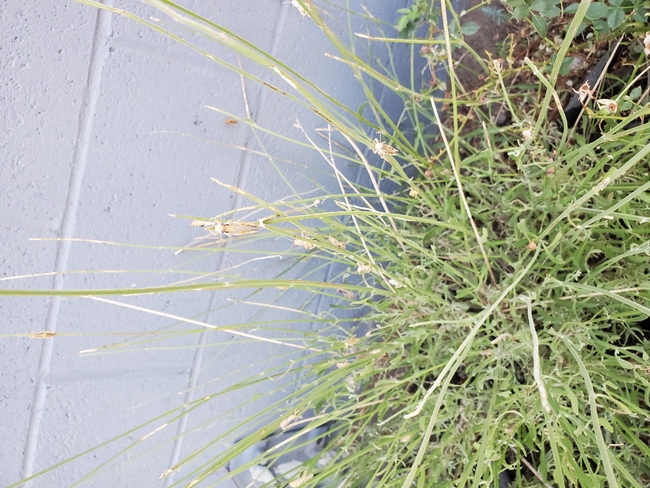
Modoc County isn't alone. Lassen, Sierra, Plumas, Siskiyou, Tehama, Butte, Placer and Nevada counties are being invaded by grasshoppers.
“The county ag commissioners are circulating a survey to get an idea of other counties that may be affected,” Snell said. “Things like droughts and – I suppose, fires as well – would affect grasshopper migrations.”
While scientists don't know what's causing the explosive growth of grasshopper populations, there are some contributing factors, according to Tom Getts, UC Cooperative Extension weed ecology and cropping systems advisor for Lassen, Modoc, Plumas and Sierra counties.
In the past, grasshopper outbreaks seemed to be more isolated, and the populations tended to crash after a year or two. Getts said, “For whatever reason, the population cycle does not appear to have been broken, and they continue to have high numbers.”
Grasshoppers can consume 30% to 250% of their body weight per day, according to a fact sheet about grasshoppers, co-authored by Getts. While grasshopper nymphs walk, adults can fly 15 miles or more.
Getts and UC Cooperative Extension farm advisors have been giving presentations throughout the intermountain region on grasshoppers and the various control methods.
“The difficulty to controlling them is the scale and their ability to move,” Getts said. “The insects need to be targeted at a small growth stage for the tactics to be most efficacious. Once they are adults, it doesn't matter what one grower does to control them if their neighbor doesn't do anything.”
UCCE farm advisors in multiple counties are working on abatement options.
They recommend monitoring in April–May to control grasshoppers while they are still nymphs and susceptible to insecticides. Birds, spiders, rodents and fungi also can help keep the insects in check, but years of drought have reduced the fungi.
“The population of grasshoppers in the region have increased in size, scope and density in recent years,” said Rob Wilson, a UC Cooperative Extension agronomy and pest management advisor and director of the Intermountain Research and Extension Center in Tulelake.
The massive growth and spread of the pests is a problem because 30 pounds of grasshoppers can eat as much forage as a 600-pound cow can eat per day, he explained.
Part of the challenge of controlling grasshoppers is their changing behavior. In the past, grasshoppers would go away after a couple of years, now they persist. They used to thrive in dry fields, but last year, grasshoppers migrated 10 to 20 miles into irrigated fields, Wilson said.
Wilson, who has been monitoring grasshoppers near Tule Lake since early April, said that In some fields, there were 20 to 30 nymphs per square yard. More than eight nymphs per square yard can cause economic damage.
As if the grasshoppers themselves weren't enough of a nuisance, they attract other pests, including blister beetles.
“As the grasshopper population increases, you are bound to see an increase in all of the species that eat them over time,” Getts said. “Blister beetles cause terrible blisters when they get on your skin, hence the name, but they can also be problematic for livestock if they contaminate bales of hay.”
Getts recommends that growers take steps to prevent grasshopper populations from building over successive years. Growers should coordinate with neighboring growers to treat their fields due to the limited longevity and efficacy of treatments on individual fields.
[Editor's note: The sentence comparing the appetite of grasshoppers to that of cows was revised to clarify that grasshoppers aren't eating cows.]
Report outlines top concerns in California organic agriculture
Organic Agriculture Institute needs assessment refines how it can address pressing challenges
The explosive growth of organic agriculture in the U.S. – reflected in a 90% increase in organic farms from 2011 to 2021, according to U.S. Department of Agriculture statistics – has come at a cost for some farmers. With new farming operations increasing the supply of organic commodities, along with consolidation of buyers, growers report that their profit margins are not what they used to be.
Those market size considerations are among the challenges highlighted in a new report detailing the initial findings by the University of California Organic Agriculture Institute on the most pressing needs of the state's organic sector. OAI gathered and analyzed data from 423 responses to an online grower survey, over 60 interviews with stakeholders across the organic community, and additional observations from farm visits and workshops.
The report describes other frequently mentioned systemic priorities, such as maintaining integrity of the term “organic,” developing a market for organic seeds, spreading consumer awareness, and alleviating the burdens of organic certification and reporting.
Shriya Rangarajan, the postdoctoral researcher with OAI leading this statewide needs assessment, said that the reported challenges varied by organic status (fully certified, transitioning to organic, or a mixed farm with some conventional), type of crop, as well as size of the operation. She noted survey respondents were roughly representative of the sector overall – 70% small-scale growers and 30% medium and large.
“Organic is not a homogenous industry, to say the least – small growers and large growers are very different; for small growers, their challenges tend to be financial and regulatory, especially relating to certification requirements and labor,” said Rangarajan. She added that larger growers mentioned different types of challenges, weeds and pest pressures for instance, given the difficulty in controlling managing these at scale without the use or availability of organic inputs.
Organic Agriculture Institute key to sharing resources across state
Another common theme from the assessment is that the organic sector needs more accessible resources to address those myriad concerns. For OAI, established in 2020 under UC Agriculture and Natural Resources, the initial findings validated and refined the direction of its research and extension programs.
“As a new organization, we've been trying to figure out where we fit into this ecosystem and how we can support it,” said Houston Wilson, a UC Cooperative Extension entomology specialist who has served as OAI's director since its founding.
Because OAI was envisioned as a hub of resources and connections for California's organic community, Wilson and his colleagues are especially interested in understanding how its constituent members obtain information – and how OAI can improve their access.
“Growers are finding it difficult to navigate the resources that exist for organic agriculture, like technical information, financial support, compliance and certification support,” Wilson said. "While we'd like to see more resources for organic in general, those that currently exist can sometimes be hard to navigate or it can be hard to know where to go for the right thing – that became really apparent early on.”
While some producers are contacting OAI directly with their questions, Wilson is eager to develop tools and systems that can serve the community more broadly. For example, Wilson and Krista Marshall – OAI's policy and partnerships coordinator – are currently beta-testing a new map tool, built in conjunction with UC ANR's Informatics and GIS (IGIS) team. The map, expected to be ready in fall 2024, will enable users to click on their county and see all available resources related to organic agriculture.
Wilson added that OAI will have four full-time staffers by fall, further expanding its research, extension, and education efforts. After holding four field events this past year, OAI aims to increase activities in the coming year, including not just field events but also online resources, webinars and more. Also, a new training and technical assistance coordinator will be tasked with bringing Cooperative Extension advisors and other technical assistance personnel across the state up to speed on a range of organic topics, so they can more effectively answer questions from clientele in their region.
New survey aims to trace crucial organic knowledge networks
Although the OAI team has gained a sense of how information is shared across the organic community (and started to formalize those interconnections through a California Organic Agriculture Knowledge Network), they are now developing a survey to study those relationships more systematically.
“We're trying to understand what kind of knowledge resources people tap into, which is something that has come up repeatedly in our needs assessment,” Rangarajan said. “We're trying to understand who people are speaking to because, at the end of the day, organic is still a relatively small part of agriculture in California, and that makes it more fragmented. So trying to connect those different parts becomes important.”
Once Wilson has a more nuanced understanding of organic knowledge networks, he will be able to strategize and position OAI – and the UC – as a more effective partner and contributor in the sector.
“Given the history of organic, growers have had to rely on each other a lot,” Wilson explained. “We understand that the university has unique expertise to bring to the table, but we also acknowledge that there's all these other knowledge holders out there, so one of the roles that we see ourselves having is helping to facilitate those connections, strengthen them and increase the frequency of interaction.”
That may include further supporting efforts that connect transitioning organic farmers with experienced growers (a mentorship program led by Certified California Organic Farmers, or CCOF), or giving more structure to grower-researcher partnerships that can help address a host of production challenges. In OAI's grower survey, weed management topped the list, followed by water and disease issues, all exacerbated by climate variability.
“I think a lot of the real innovation changes are coming through growers experimenting with their own practice,” Rangarajan explained. “From a research perspective, one of the best ways to take this forward would be to formalize those experiments in some way so that knowledge becomes more reportable.”
And collaboration on “organic topics,” such as finding alternatives to synthetic pesticides, are a boon to the entire agricultural sector – conventional growers included.
“Everyone is trying to reduce pesticide use; everyone is trying to reduce environmental impacts,” Wilson said. “You don't have to be certified organic to benefit from organic research; these practices can be used by anyone.”
The report with OAI's initial findings on organic needs can be found at: https://ucanr.edu/sites/organic/files/396228.pdf.
New pest infesting almonds and pistachios in the San Joaquin Valley
Crop sanitation will be key to controlling the invasive carpophilus beetle
Growers and pest control advisers (PCAs) should be on the lookout for a new pest called carpophilus beetle (Carpophilus truncatus). This pest was recently found infesting almonds and pistachios in the San Joaquin Valley, and is recognized as one of the top two pests of almond production in Australia. Damage occurs when adults and larvae feed directly on the kernel, causing reductions in both yield and quality.
Populations of carpophilus beetle were first detected in September in almond and pistachio orchards by University of California Cooperative Extension Specialist Houston Wilson of UC Riverside's Department of Entomology. Pest identification was subsequently confirmed by the California Department of Food and Agriculture.
Wilson is now working with Jhalendra Rijal, UC integrated pest management advisor, North San Joaquin Valley; David Haviland, UCCE farm advisor, Kern County; and other UCCE farm advisors to conduct a broader survey of orchards throughout the San Joaquin Valley to determine the extent of the outbreak.
To date, almond or pistachio orchards infested by carpophilus beetle have been confirmed in Stanislaus, Merced, Madera and Kings counties, suggesting that the establishment of this new pest is already widespread. In fact, some specimens from Merced County were from collections that were made in 2022, suggesting that the pest has been present in the San Joaquin Valley for at least a year already.
“It has likely been here for a few years based on the damage we've seen," Rijal said.
This invasive beetle overwinters in remnant nuts (i.e. mummy nuts) that are left in the tree or on the ground following the previous year's harvest. Adults move onto new crop nuts around hull-split, where they deposit their eggs directly onto the nut. The larvae that emerge feed on the developing kernels, leaving the almond kernel packed with a fine powdery mix of nutmeat and frass that is sometimes accompanied by an oval-shaped tunnel.
Carpophilus beetle has been well-established in Australia for over 10 years, where it is considered a key pest of almonds. More recently, the beetle was reported from walnuts in Argentina and Italy as well. Carpophilus truncatus is a close relative to other beetles in the genus Carpophilus, such as the driedfruit beetle (C. hemipterus) that is known primarily as a postharvest pest of figs and raisins in California.
Monitoring for carpophilus beetle is currently limited to direct inspection of hull split nuts for the presence of feeding holes and/or larvae or adult beetles. A new pheromone lure that is being developed in Australia may soon provide a better monitoring tool for growers, PCAs and researchers.
“We're lucky to have colleagues abroad that have already been hammering away at this pest for almost a decade,” said Haviland. “Hopefully we can learn from their experiences and quickly get this new beetle under control.”
The ability to use insecticides to control carpophilus beetle remains unclear. The majority of the beetle's life cycle is spent protected inside the nut, with relatively short windows of opportunity available to attack the adults while they are exposed. The location of the beetles within the nut throughout most of their life cycle also allows them to avoid meaningful levels of biological control.
In the absence of clear chemical or biological control strategies, the most important tool for managing this beetle is crop sanitation.
“Given that this pest overwinters on remnant nuts, similar to navel orangeworm, crop sanitation will be fundamental to controlling it,” Wilson said. “If you needed another reason to clean up and destroy mummy nuts – this is it.”
In Australia, sanitation is currently the primary method for managing this pest. And here in California, new research and extension activities focused on carpophilus beetle are currently in the works.
“It's important that we get on top of this immediately,” said Wilson. “We're already starting to put together a game plan for research and extension in 2024 and beyond.”
If you suspect that you have this beetle in your orchard, please contact your local UC Cooperative Extension farm advisor (https://ucanr.edu/About/Locations/), County Agricultural Commissioner (https://cacasa.org/county/) and/or the CDFA Pest Hotline (https://www.cdfa.ca.gov/plant/reportapest/) at 1-800-491-1899.
USDA awards $2 million to study livestock grazing in organic orchards
UC, The Organic Center, University of Rhode Island partner on $3.5m food-safety study for organic produce growers
Grazing sheep and other livestock can help convert cover crops to fertilizer for orchard crops. To develop best management practices, the University of California and The Organic Center are collaborating on research to help organic orchard growers safely incorporate livestock grazing into their farming practices. The project is funded by a $2 million grant recently awarded through the U.S. Department of Agriculture's Organic Agriculture Research and Extension Initiative research program.
Interest in grazing livestock on cover crops in nut orchards has increased in recent years. However, research is needed to determine the best way to improve soil health and pest suppression, and to address concerns about food-borne pathogens and food safety.
“Organic farmers typically follow the USDA National Organic Program standards for raw animal manure, waiting 90 to 120 days between incorporating raw manure into the soil and harvesting the crop,” said Alda Pires, UC Cooperative Extension urban agriculture and food safety specialist in the School of Veterinary Medicine at UC Davis.
“Little research has been conducted to verify adequate waiting periods to reduce contamination risks in integrated crop-livestock production systems,” she said. “This research will fill the knowledge gap and facilitate the development of science-based food safety guidelines for grazing small ruminants in orchards.”
For this four-year project, “Influence of Orchard Grazing on Soil Health and Pest Control While Mitigating Food Safety Risk,” the scientists will study organic almond, walnut and pistachio orchards in two distinct nut-growing regions in California – the Sacramento Valley and San Joaquin Valley. The scientists will assess the effects of livestock grazing of cover crops on bacteria populations, soil health, pest control and economics.
Building soil health
“Growers have consistently raised the need for more information on grazing impacts on nutrient availability during tree growth, as well as potential to build up the biological, physical and chemical pillars of soil health,” said Amelie Gaudin, associate professor and endowed chair of agroecology in the UC Davis Department of Plant Sciences.
Livestock grazing may provide an opportunity to quickly enhance the amount of nitrogen that can be used by plants and microbes when the cover crop is terminated. “This project will help growers develop nitrogen budgets for these more diversified systems and quantify additional benefits and potential tradeoffs for soil health – such as compaction and salinity – to guide the development of place-based best management practices,” Gaudin said.
Pest management
Houston Wilson, UC Cooperative Extension specialist in the Department of Entomology at UC Riverside, will be studying the effects of livestock grazing on orchard pests.
“Navel orangeworm, or NOW, is by far the most destructive pest of almonds and pistachios,” Wilson said. “These moths overwinter in unharvested nuts in the orchard, and so removal and destruction of remnant nuts over the winter is the foundation of NOW control. While farmers typically use machinery to do this, grazing with animals may present a unique alternative that is more cost-effective and provides additional ecosystem benefits, such as soil health and weed control.”
Outreach to farmers
As part of the project, The Organic Center was awarded $75,000 to work with UC Agriculture and Natural Resources to direct national extension and education outreach activities. These will include a social media campaign, webinars and educational sessions and a technical report for growers.
“There is an increasing interest from organic farmers to learn how to incorporate livestock into their operations to gain better soil health and fertility,” said Amber Sciligo, director of science programs at The Organic Center.
“This research is very exciting because it will holistically explore the potential risks and benefits of livestock not just to soil health, but also pest control – a truly interdisciplinary project that matches the whole system of the organic farm.”
Produce food-safety management tools
For another organic food-safety project, Pires and Sciligo will be working with Patrick Baur, professor of Sustainable Agriculture and Food Systems at the University of Rhode Island.
The University of Rhode Island and The Organic Center received $3.5 million from USDA's Organic Agriculture Research and Extension Initiative research program for the new organic food-safety education project.
“We're going to develop a new food safety management tool designed specifically for organic soil amendments,” said Baur, who is leading the project. “We're also going to develop a suite of new communication and training tools aimed at the entire fruit and vegetable sector to build a shared language between organic agriculture and the food safety community and help them work better together.”
As part of the produce project, Pires of UC Davis was awarded $1.16 million to conduct a risk assessment and create a publicly accessible dashboard to meet the specific needs of organic growers operating at different scales, under different cropping systems, in different regions.
Also participating in this project will be Beatriz Martinez Lopez, professor in the School of Veterinary Medicine at UC Davis, and Abhinav Mishra and Govindaraj Dev Kumar of the University of Georgia.
Electric tractors reduce carbon emissions at UC ANR research and extension centers
Zero-emission tractors perform many tasks of diesel tractors, without noise or exhaust
The University of California, a national leader in sustainability, has pledged to become carbon neutral by 2025. To reduce its reliance on fossil fuels, UC Agriculture and Natural Resources has replaced several of its diesel-powered tractors with electric tractors at its research and extension centers.
Seven of the nine UC research and extension centers – Intermountain located in Siskiyou County, Hopland in Mendocino County, Kearney and West Side in Fresno County, Lindcove in Tulare County, Desert in Imperial County and Hansen in Ventura County – started using the Solectrac e25 in July. The researchers plan to share what they learn from using the electric tractors.
“Charging is easy, we are using a standard 110V connection, no charging station needed,” said John Bailey, director of the University of California Hopland Research and Extension Center. “For faster charging, you can use a 220V connection – again, no charging station needed, just a regular receptacle – but we haven't gone there yet.”
The electric tractor runs for about five hours, depending on the type of use and the speed, on a charge.
“We will use the electric tractor to mix the soil for planting trees in the greenhouse,” said Ashraf El-kereamy, director of UC Lindcove Research and Extension Center in Exeter, which focuses on citrus research. “Also, for pulling the trailer with the fruit bins during harvest, it will be good as it does not emit any gases.”
The electric tractor is being used to move materials in the loader at UC Hopland REC. “It has worked well for this, functioning similarly to a standard diesel tractor,” said Bailey.
“We have also used it to clean our sheep barn, scraping the pens to get ready for lambing season,” Bailey said. “This involves pushing or dragging straw bedding and manure. The tractor functions well in tight spaces due to its compact size.”
Bailey learned one downside is that the front end is a little too light, making it difficult to generate enough downward pressure with the loader to effectively scrape the floor without reducing the front wheel traction.
“We are planning to add some weight to the front, a standard practice with tractors to increase traction. The tractor has the mounting to enable this so it should not be a big deal,” Bailey said. “Our operators really appreciate the lack of noise and exhaust, especially when working in the barn or in tight spaces.”
The small electric tractor is also being used in tight places at the UC Intermountain Research and Extension Center in Tulelake.
“The tractor that we obtained from the company is too small for the majority of our farm needs,” said Rob Wilson, Intermountain REC director. “We purchased a small box scraper and rototiller for the tractor and we are using it around our facility grounds. We also use it out in the field in tight spaces that are too small for our larger tractors to operate.”
“The tractor is quiet, powerful for its size and operates very similar to the diesel-powered tractors with regard to the controls, hydraulics and three-point assembly. The tractor also has a lot of torque and speed.”
Annemiek Schilder, director of UC Hansen Agricultural REC, added, “I think another advantage is that the tractors can go very slowly, which is helpful for some uses such as harvesting.”
The researchers will continue to evaluate the electric tractors throughout the year.
“Our main usage will come in the spring, mowing around our headquarters and on roadsides,” Bailey said. “We are purchasing a 4-foot flail mower that can mount to the rear PTO, but won't really put it into use until April.” The power take-off, or PTO, is the shaft that transfers power from the tractor to the attachment.
Other benefits of electric tractors include no engine oil to change and no diesel fuel.
“If the farmer already has solar, they will see close to zero fuel charges,” Bailey added. “Even without solar, their fuel costs should be reduced depending on local electrical cost. Also, the engine only has one moving part compared to dozens in a diesel tractor so maintenance costs should be reduced significantly, something that is proving true in electric cars.”
The Solectrac e25 tractors each cost $27,999 and the optional loader was about $4,000.
The California Air Resources Board is offering incentives to buy zero-emission equipment through its Funding Agricultural Replacement Measures for Emission Reductions Program. FARMER provides funding through local air districts for agricultural harvesting equipment, heavy-duty trucks, agricultural pump engines, tractors and other equipment used in agricultural operations.


